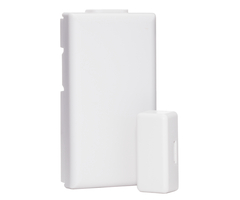Honeywell 5811 vs 5816
The Honeywell 5811 and Honeywell 5816 are both wireless door/window contacts which work well with the Honeywell Lynx Touch 5100 wireless security system as well as with the Honeywell 6160RF and Honeywell 6150RF keypads with integrated wireless receivers. They also work with any Honeywell wired system that has been upgraded with one of the Honeywell 5881 wireless receivers (5881ENL, 5881ENM, 5881ENH, 5881ENHC) or the 5883h wireless transceiver module.
The older, boxier 5816 (3 inches high x 1.5 inches wide x 1.25 inches deep) has a range of 200 nominal feet and can be recognized by its five horizontal ridges that run across the cover. The newer, slimmer 5811 (2.25 inches high x 1.25 inches wide x 3/8 inches deep) has a range of 150 nominal feet from the closest RF receiver.
While the 5811 protects a single window/door with its single wireless zone, the 5816 has internal screw terminals which can be utilized to hard wire an additional zone to any wired door/window contact. It is important to note that MOST wireless sensors including the 5811 (see video 1 below) should be programmed to loop 1. Watch the following video if you would like to see Sterling program a 5811 sensor to the L5100.
However, the only exception to this rule is programming the 5816 where loop 1 is allocated to the hardwired zone when you have a wired sensors connected to the 5816 and loop 2 is designed to communicate with the wireless zone when you use the 5816 as a standalone device. You can even program both loops to utilize two zones with one device. When loops are improperly programmed, the zone will not operate properly and you may experience faults when there are no faults and faults that don't restore when they should. Make sure to verify your programming has the proper loop to prevent these issues from occurring. For further instructions on programming the 5816, watch the following video:
The 5816 uses a larger, cylindrical Panasonic Lithium CR123A 3V battery; while the 5811 uses a smaller, disc-shaped Panasonic Lithium CR2032 3V battery. According to Honeywell, the 5816 battery is listed to last 3-5 years and the 5811 to last 4 years, on average.
Since doors and windows vary it is important to ensure that your 5816 is no further than 0.5 inches from the included Honeywell 5899 magnet and aligned between the two plastic hash marks along its side. The 5811 should be no further than 0.75 inches from the included Honeywell magnet and aligned between the small ridges on the side of the plastic case. Honeywell does not offer replacement magnets for the 5811 so we recommend you use either the Honeywell 943-WG-M or the Honeywell 945-M.
Did you find this answer useful?
We offer alarm monitoring as low as $10 / month
Click Here to Learn MoreRelated Products

Related Videos
Related Categories
- Answered
- Answered By
- Frank Longo





